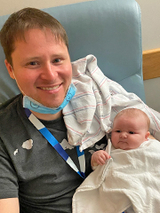Treating Hyperinsulinism During a Pandemic: Stella’s Story
Treating Hyperinsulinism During a Pandemic: Stella’s Story
Lindsay brought her very sick newborn daughter Stella to Children’s Hospital of Philadelphia (CHOP) on March 12. When they went back home to Charlotte, NC, five weeks later, their world was forever changed in two ways.
The COVID-19 pandemic had swept across America, including Philadelphia; and Stella was cured of congenital hyperinsulinism (HI). The first event did not interfere with the second.
“It was an interesting time to be in the hospital,” Lindsay says. “We never felt her care was compromised because of COVID.”
Help managing hypoglycemia before arrival

Stella was cared for by the expert team from CHOP’s Congenital Hyperinsulinism Center, the most active and experienced center of its type in the world. In fact, doctors at her birth hospital, Levine Children’s Hospital in Charlotte had consulted with the HI Center soon after Stella’s birth. An alert delivery room nurse saw Stella was lethargic in her first minutes of life and suspected low blood sugar.
“They checked it straight away, and it was 15,” says Lindsay. During the first few hours after birth the average blood glucose in a newborn baby is around 55-65 mg/dL, “so they immediately gave her glucose.” That kept her sugar level high enough to prevent damaging seizures. When it stayed low, “they honed in on HI quickly and started talking with CHOP.”
In hyperinsulinism, the beta cells in a child’s pancreas release too much insulin, pushing blood sugar levels dangerously low, a condition called hypoglycemia.
About Hyperinsulinism
In congenital hyperinsulinism, the insulin cells of the pancreas (beta cells) secrete too much insulin and at the wrong time.
Stella didn’t respond to the usual medications to raise her sugar levels, meaning she needed care beyond what she could get in Charlotte. Levine Children’s Hospital had sent other HI patients to CHOP in the past, and within a few days, plans were set to bring Stella and Lindsay north on a medical jet while husband Matt stayed home with their 2-year-old, Margot.
Changing practices, always safe
Their first couple of weeks were a whirlwind of tests to determine the type of HI Stella had, since that guides treatment. At the same time, CHOP’ safety practices were evolving to stay in line with recommendations from the Centers for Disease Control and Prevention (CDC). CHOP was committed to remain open for patients like Stella, who needed urgent care, while preparing to treat any children who came in with COVID-19 symptoms in an area isolated from the general patient population.
Patient families were updated on guidelines as protocols evolved when more information on COVID-19 and how to prevent its spread became available.
“Things were continually changing in response to what was happening,” Lindsay says. At first, family members didn’t need to wear masks. After a few weeks, as more was learned about how the coronavirus spread, masks were mandated whenever parents left the child’s room and while any care provider came into the room as an extra layer of precaution to keep everyone safe.
“They were very receptive to feedback from families about how the policies would affect us,” she says. Though visitor restrictions for siblings and other visitors were in place to limit the number of people entering the hospital, two parents could accompany any patient.
That meant Matt could come to CHOP to be with Stella when she had surgery.
Inconclusive tests, fast surgery

Neither genetic tests or a special CHOP-developed PET scan could conclusively determine if Stella had focal HI, which can be cured with a partial pancreatectomy, or the diffuse type of HI, which requires most of the pancreas to be removed and, subsequently, years of medication and dextrose (sugar water) tube feedings.
However, once Surgeon-in-Chief N. Scott Adzick, MD, got a look at Stella’s pancreas in the operating room, he could clearly see a focal lesion, a concentrated area of overactive beta cells, and removed just that section. The whole multidisciplinary team came together virtually during the surgery to examine images of cells from pancreatic tissue surrounding the focal lesion to confirm.
“When he came into the waiting room so quickly after the surgery started, we thought he was just giving us a report that it was diffuse,” Matt says. “Of course, we had hoped it would be focal so we were thrilled. Dr. Adzick said it was straightforward after he got in there.”
Stella stayed a couple more weeks for her incision to heal and to make sure she could pass a fasting test to prove she was cured. She passed with flying colors.
Excellent, remarkable, amazing
We were in and out of there in five weeks. It was remarkable. Stella received excellent care.
Lindsay also was thankful the HI Center team and others who cared for Stella recognized it was an especially stressful time to be a parent of a child with a serious condition and in the hospital.

“They were concerned with Stella, obviously, but about me as well,” Lindsay says. “They were willing to do anything they could to make things easier. We very much appreciate everyone’s hard work to get us back home as quickly as possible.”
Now 6 months old, Stella is hitting her milestones and is “perfectly happy,” her mom says.
“Overall, we had a fantastic experience. Stella is doing great.”